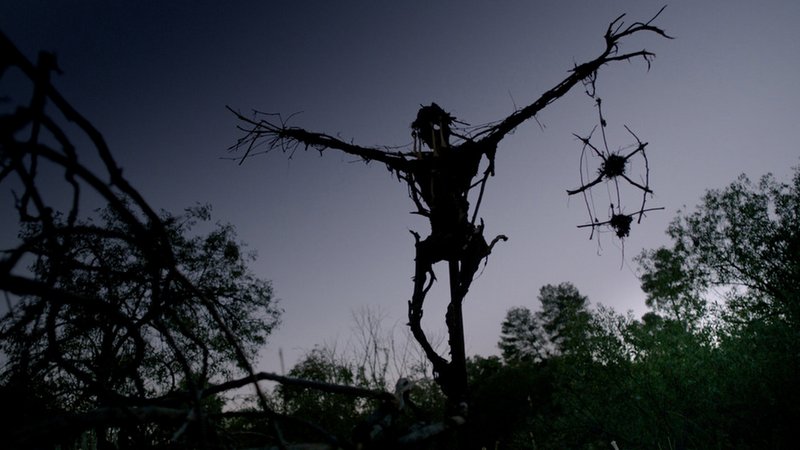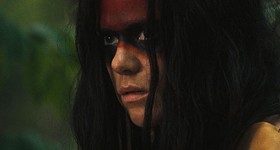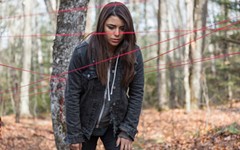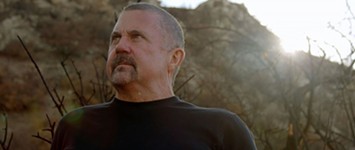DVDanger: All This Horror Business
Catching up with the major terror releases
By Richard Whittaker, 9:00AM, Sat. Jul. 26, 2014

Ruggero Deodato is a delightful dining companion. I broke bread with the legendary 75-year-old Italian director last year during the Housecore Horror Film Festival, and he insisted on taking iPhone pictures of everyone at the table, like a proud and tech-savvy grandfather.
That's a big change to how he made his reputation. For good or ill, his 1979 underground classic Cannibal Holocaust sets the disturbing bar for gross-out horror. Now it emerges from the vaults of Grindhouse Releasing in a three-disc edition.
Cannibal Holocaust is often remembered as the godfather of found footage films. In a way, yes. But the found footage is only part of the story. The film begins in New York, with NYU anthropologist Harold Monroe (Robert Kerman) dispatched to find out what happened to a team of four documentarians, last seen in the Amazon rain forest. What he discovers is that they had wandered into the middle of an endless war between three tribes: the warrior Yacumos, the hunter-gatherer Yanomamö, and the predatory Shamatari. He finds the filmmakers' stripped bones and cans of footage, and convinces the tribe to let him bring the film reels back to America, where a TV station plans to air them. "Today people want sensationalism," boasts one TV producer. "The more you rape their senses, the happier they are." When the broadcasters find out exactly what's in it, the question becomes, how provocative can they really be, and still be seen as civilized?
Narratively, that framing mechanism of found footage within a conventional narrative blows an obvious hole in the idea that this is real (an argument Deodato actually had to make to Italian prosecutors). While some critics have laid into The Blair Witch Project for stealing the concept of filmmakers in peril, it's not like Deodato was working in a bubble. Barring the found footage, Cannibal Holocaust is mostly a remake of his own 1997 film, Ultimo Mondo Cannibale, and the disturbing shrines that dot the jungle show the clear influence of Bob Burn's set designs for The Texas Chain Saw Massacre.
Clearly, this comprehensive re-release has been spurred by the imminent release of Eli Roth's cannibal homage Green Inferno; in fact, Roth's film takes its title from Gianfranco Clerici's original script for Deodato's film. Proving that even hardened gore fans can have their limits, Grindhouse has included both the full edit (complete with genuine and graphic tribal hunting sequences) and one for those whose tastes are limited to fictionalized mutilations. But that's the only point at which this film provides respite.
This remains one of the most graphic films ever, and Deodato never flinches. The cannibal films were the heirs to the mondo genre of shocking documentaries for shock's sake. Deodato even includes mondo-esque footage of real atrocities, as if to underline exactly how inhuman people can be. Strangely, it takes a little of the edge off the fictional horror, because that is often so crazed and disturbing that it seems clearly implausible.
Cannibal Holocaust is gruesome, and it's not for most people – not even most horror fans. But for every stomach-churning image (such as the famous impalement sequence) there's one of how beautiful the jungle is. The weird pastoralism of the affair is re-enforced by Riz Ortolani's often delicate and charming score (included here as its own CD). And there are undoubtedly breathtaking moments, as Deodato filmed on location along the Amazon in Colombia. In an extremely frank and bilingual commentary track with Kerman, he recounts tales of drunk actors, spies, borrowed guns, extras hired from the local brothel, and the extreme risk of South American passenger planes.
There's an interpretation that says that Deodato is criticizing Westerners for interloping on the ways and customs of the tribes. But then he's not exactly a fan of their barbarous ways either. In fact, he's no fan of anyone, really, and the press least of all. There's an unavoidable subtext here that, by provoking the natives and acting like they're above repercussions, the film crew brought it on themselves. Cheerful stuff.
Of course, there's the question of what responsibility Deodato must face, for casting indigenous people in a horror film. But then, as Roth found out when he shot his own film under such circumstances, the tribespeople found the story absolutely hilarious.
And that's where the animal slaughter becomes arguably the most intriguing part of the film. Everything that was killed in the movie was eaten, mostly by the tribes, some by the cast and crew. As Deodato notes, with a degree of disdain, even though he probably would not have shot those sequences now for artistic and narrative reasons, they seem so much worse now because audiences have become so separated from death, and have little idea where their meat comes from. That's arguably why Criterion included George Franju's documentary about the Paris cattle markets, "Blood of the Beasts,", in their recent re-release of Eyes Without a Face.

There's far more creature killing, but of the wholly fictional kind, in Deadly Eyes (Scream! Factory). This time, it's giant rats scampering around the New York sewer and subway systems, stealing babies and chewing off faces.
Loosely (very, very, very loosely) adapted from British horror author James Herbert's seminal nightmare The Rats, the 1982 skittering shocker relocates the action from post-war London to Toronto. Yes, this is part of the glorious Canucksploitation era, which explains the inclusion of two of the scene's greatest actresses: self-described scream princess Lisa Langlois and the perennial best friend Lesleh Donaldson (so great in Happy Birthday to Me and the sadly forgotten Curtains).
They're just two cogs in a surprisingly densely packed cast, including Sam Groom as a high school teacher who happens to be friends with rodentologist Dr. Spencer (Cec Linder), and becomes involved with a health department inspector Kelly Leonard (Sara Botsford). She's most worried about the possibility of a new strain of super rat, mutated by hormone-drenched corn. After several unlikely candidates become tasty mouse morsels (including an extremely high Scatman Crothers and a baby), it's pretty clear that someone better put down a lot of traps.
Deadly Eyes is mostly famous for its Hong Kong connection: Produced by martial arts masters Golden Harvest and directed by Bruce Lee associate and American kung fu flick pioneer Robert Clouse (Enter The Dragon, Game of Death, China O'Brien), it's either's sole entry into the English language horror canon. But it's all also surprising effective as an early Eighties creature feature. The rats – a mix of animatronics and adorable Wiener dogs in suits – are oddly effective, and Clouse doesn't relent on the body count. Nor is he seemingly that bothered about his cast's safety, the way he lets Groom swing a jury-rigged flamethrower around in a confined space at the film's fur-singeing denouement.
Fortunately, some of the more blood-curdling aspects of Herbert's book survive, even though scripter Charles "Chic" Eglee proudly announces in the extras that he never even read the original novel. (Incidentally, he took the same approach when he took over as showrunner of Netflix's Hemlock Grove.)

Taking a more cerebral approach to scares is Mr. Jones (Anchor Bay), a May release that has been sitting on my "must-watch" pile for a while. It finally hit the top of the stack.
The first directorial credit for Karl Mueller (best known for scripting nihilist post-apocalyptic depressant The Divide), Mr. Jones is less found footage and more full-fledged impressionistic mockumentary. It tells the story of a pair of artists: wannabe documentarian Scott (Jon Foster, ABC's Life As We Know It) and art photographer Penny (Sarah Jones, aka Polly, the daughter of Nazi scumbag Ethan Zobelle in Sons of Anarchy). They decide to take a year off while Scott works on a nature documentary, which quickly translates into him doing nothing for two months, and the documentary quickly proving to be a formless mess of deer and sunrises.
And then they find the scarecrows. Their next door neighbor, out in the middle of nowhere, is Mr. Jones, a mysterious outsider artist who does more than drop a barbecue grill in some cement. He's a quasi-mythical figure who has been creating bizarre and arcane figures, then mailing them at random to people around the world. Penny, a fan of his mysterious work, is immediately captivated by living next to gothdom's answer to J.D. Salinger. Scott suddenly sees fodder and a new direction for his documentary. But, of course, nothing can be as simple as that, when the few people who have even a glimmer of knowledge of Jones' work start talking about totems and shaman and the world beyond our world.
Designed by another vaguely mysterious artist, Pumpkinrot, the scarecrows are undeniably creepy – much like the rest of the film. When Scott goes to New York, to find anyone who has a clue about Jones, and Penny probes their neighbor's mysterious art installations, it's clear that the world is about to tumble down. By sheer coincidence, the sense of Lovecraftian menace, combined with bizarre totems, will strike a resonance with fans of True Detective. Meanwhile horror fans will see an undeniable kinship to the doom-laden lo-fi creations of an actual Blair Witch alum, Eduardo Sanchez, most especially 2012's possession drama Lovely Molly.
In its second half, Mr. Jones becomes a full-fledged uncanny horror, dabbling in dark waters somewhere between the cosmic dread of A Field in England and the psychological angst of Eternal Sunshine of the Spotless Mind. Really, it's like a less by-the-numbers Insidious, and has a lot more visual creativity in its other realms than just some dry ice and a couple of green bulbs.

Speaking of creativity, dahlinks, I absolutely adored the madcap and ludicrous Stage Fright (Magnet) when it appeared at SXSW. Now it's made its way to a home release, and it's still a silly, giddy midnight romp.
It's that rarest of creations: a successful horror musical. Admittedly, that isn't a major genre, but then, there are good reasons why people rarely try it. Actual gore and actually singable songs, there's a pretty minimal crossover. The classics of the genre – Little Shop of Horrors and The Rocky Horror Picture Show – are pretty bloodless. Arguably, the only notable and memorable examples that include some actual bloodshed are cult attractors: Repo: A Genetic Opera and Tim Burton's adaptation of Sondheim's Sweeney Todd (and, no, I'm not part of the revisionist party when it comes to de Palma's catastrophe, The Phantom of the Paradise).
Part Scream, part classic summer camp massacre, and a lot of love-hate of Phantom of the Opera, Stage Fright sets its tone from the first word out of Minnie Driver's lips – or rather, how she delivers it. She plays Kylie Swanson, a thinly veiled lampoon of Andrew Lloyd Webber's muse Sarah Brightman, appearing in a just-distinct-enough-for-copyright spoof of Phantom. That is, until she is dispatched at knife point by a masked figure. Years later, her children Camilla (Allie MacDonald, House at the End of the Street, Stories We Tell) and Buddy (Douglas Smith, Big Love) are under the care of failed impresario Roger McCall (Meat Loaf), who has been reduced to running a theatre camp. Of course, ghosts and old productions never lie still forever, so when one of the more arrogant twerps (the self-appointed production director, n'est-ce pas) decides to re-stage The Haunting of the Opera, and Camilla auditions for the same part as her mother, inevitably the blood will spill and the rafters will ring.
While a highly entertaining horror-comedy (leaning hard on slapstick), Stage Fright adds the bitter and humorous stabs of recognition for anyone who has ever been in a school play, or dabbled in amateur dramatic. The camp itself is a smörgåsbord of misfits, lispers, fat kids, closet cases, and dweebs who abuse that sliver of power they get. But then, it's actually got a couple of really solid and creative kills. (Someone spent a lot of time in lighting gantries, contemplating ways to dispatch annoying directors. Director/librettist Jerome Sable may be working through some issues.)
The choral high point is undoubtedly the show's own "Hail to Thee, Kamp Krusty," the jubilant "We're Here," and now, courtesy of the mandatory sing-a-long inclusion, you can organ your way through it at home. And particular kudos to the director and Magnet for adding a full-blown apology to Steffi DiDomenicantonio, the actress who appears in the background as a Liza Minnelli look-a-like, but was actually the victim of some merciless editing.
Will it reach the cult status of, say, the Buffy the Vampire Slayer musical episode, "Once More With Feeling"? Hard to say. Cults are unpredictable things (just ask Mr. Jones), but there are worse reasons for horror fans to bang out a few show tunes.
Cannibal Holocaust (Grindhouse), Deadly Eyes (Scream! Factory), Mr. Jones (Anchor Bay) and Stage Fright (Magnet) are out now on DVD and Blu-ray.
A note to readers: Bold and uncensored, The Austin Chronicle has been Austin’s independent news source for over 40 years, expressing the community’s political and environmental concerns and supporting its active cultural scene. Now more than ever, we need your support to continue supplying Austin with independent, free press. If real news is important to you, please consider making a donation of $5, $10 or whatever you can afford, to help keep our journalism on stands.
Richard Whittaker, April 19, 2018
Richard Whittaker, April 3, 2018
Richard Whittaker, July 21, 2018
Richard Whittaker, July 14, 2018
April 19, 2024
April 19, 2024
DVD Watch, DVDanger, Scream! Factory, Anchor Bay, Grindhouse Releasing, Magnet Releasing, SXSW, Stage Fright, Mr. Jones, Deadly Eyes, Cannibal Holocaust, Ruggero Deodato, The Rats, James Herbert, Jerome Sable, Robert Clouse, Karl Mueller, Charles "Chic" Eglee












